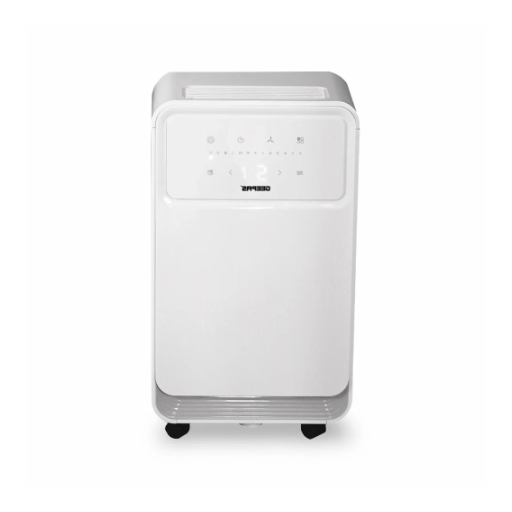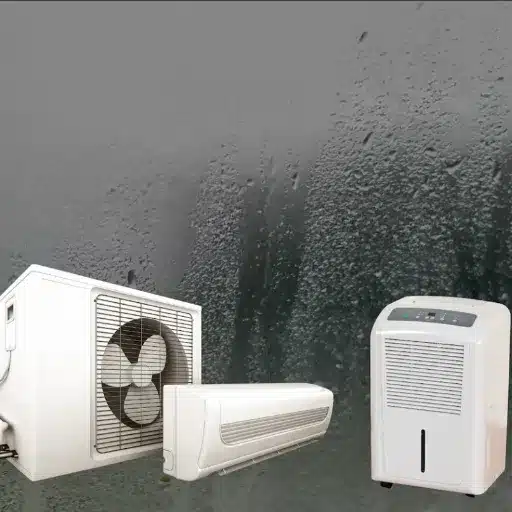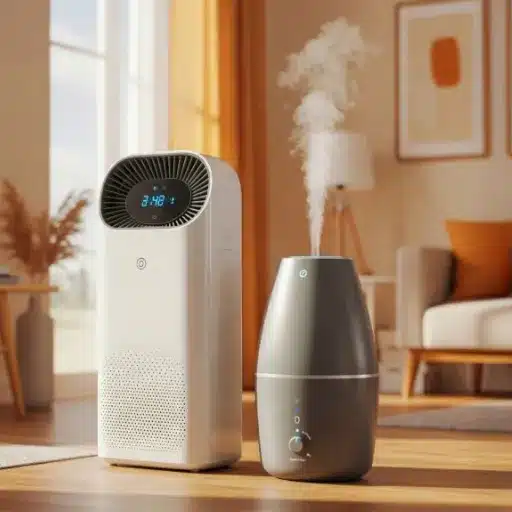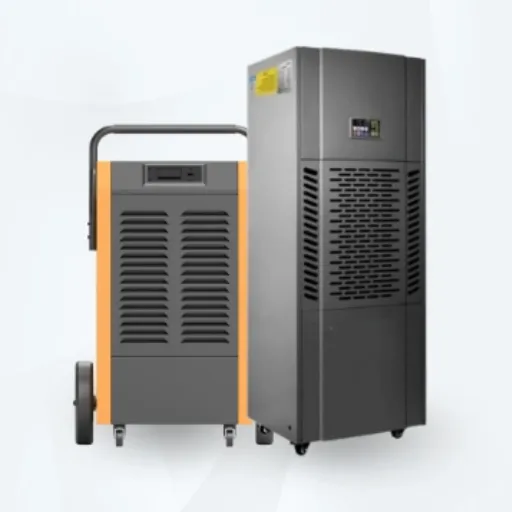Controlling indoor climate is essential for maintaining comfort, health, and energy efficiency, but understanding the right tools for the job can be challenging. Two common appliances that often play a role in this process are dehumidifiers and air conditioners. While both devices can influence humidity and temperature, their functionalities, benefits, and best-use scenarios vary significantly. This article will explore the key differences between dehumidifiers and air conditioners, highlighting how each works, when to use them, and the unique advantages they offer. Whether you’re looking to improve air quality, reduce energy costs, or enhance indoor comfort, this guide will provide the insights you need to make an informed decision.
How Do Air Conditioners and Dehumidifiers Work?
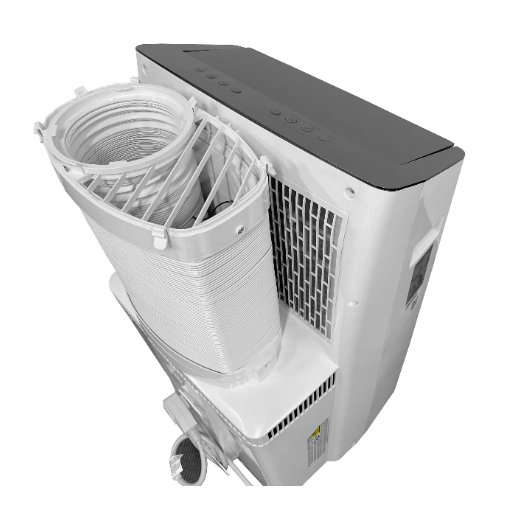
Mechanism of Air Conditioners
Heat gets removed from the indoor air through a process called heat exchange in an air conditioning system. The system works using a refrigerant-a special fluid that absorbs heat and releases it when it is converted from a liquid to a gas or vice versa. Warmed-up inside air is taken in by the air conditioner, particularly by the evaporator coil; here, the refrigerant takes the heat out of the air, leaving it cool. This cold air is then released inside, where it lowers the temperature indoors to a comfortable level.
The refrigerant, absorbing the heat and converting into gas, is taken into the compressor unit. The compressor then compresses the refrigerant to a very high pressure so that the temperature of the refrigerant increases. At this point, the refrigerant exists as a gas at high pressure and temperature and is forced to pass through the condenser coil, which usually lies outdoors. Here, the condenser coil releases the heat into the outdoor environment as the refrigerant turns back to a liquid form. The whole process goes on until the temperature inside reaches the desired level.
By their cooling mechanism, air conditioning and humidity removal are secondary effects. Moisture in the air is rendered liquid on the evaporator coils and sent away through condensate drains during the cooling operation. That said, this is just a happy byproduct since their major function is heat control, meaning the concept works wonders in places where heat reduction is desired.
Functionality of Dehumidifiers
Dehumidifiers are machines that are designed to get rid of excess moisture and attain an indoor humidity level. Dehumidifiers draw in moist air from the air-conditioned outside, where it gets cooled to a temperature at which water vapor condenses into liquid form; the liquid is then collected and drained. The dried air is then warmed and carried back into the environment, rendering a pleasant and healthy ambiance in the interior.
Their principal use is to avoid the unpleasant consequences of high humidity, like mold growth, mite population, and damage to buildings and furniture. These appliances are even more beneficial in areas with a constant high humidity level, like a basement or a region with very wet weather. Dehumidifiers reduce moisture to a point where air quality is improved, thus preventing potential health hazards caused by allergens and bacteria.
It is imperative to choose your dehumidifier according to the unusual requirements of your establishment. The area size, level of humidity, and energy efficiency are some considerations that will affect your choice. Usually, modern dehumidifiers are equipped with extra features, such as humidistats, adjustable fan speeds, and an automatic shut-off mechanism, for added function and easier use.
Comparison of Operation Methods
There are mainly two ways through which a dehumidifier works: refrigerant (compressor) based or desiccant based. For refrigerant dehumidifiers, humid air is pulled in and passed over the cold coils such that moisture condenses and either gets collected in the tank or drained. In warm and humid conditions, they work best and hence are great for residential settings or regions that experience mild to high temperatures. This method proves to be energy-saving, plus it can maintain a dry atmosphere consistently, even in larger areas.
Desiccant dehumidifiers absorb moisture directly from the air, using any number of hygroscopic substances. They do not require cooling coils and thus have the advantage of working efficiently over a broad temperature range, including cold weather. This makes desiccant dehumidification suitable for basements, industrial applications, and situations where noise and performance in cold environments are critical factors. Generally, desiccant systems are quieter than refrigerant systems but use more energy.
In deciding between these two methods, take into consideration factors like the exact building environment, its energy efficiency usage, and the purpose of the installation. For warmer climates and energy-conscious consumers, refrigerant-based models may provide the best all-around performance. For colder climates or highly specialized uses, desiccant dehumidifiers may be the better performers. Both systems come with a wide array of modern controls and options nowadays, allowing the user to fine-tune their operation on the basis of personal preference and the needs of the space.
Humidity Levels and Their Impact
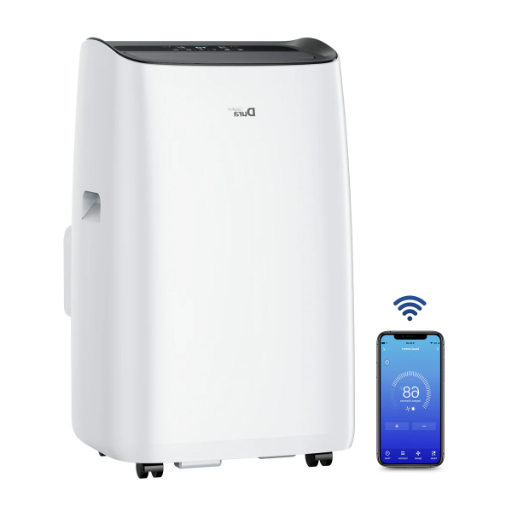
Understanding Humidity and Its Effects
Humidity- the concentration of water vapor in the air-affects the environment and human health. Controlling humidity is necessary to retain indoor air quality, for the preservation of materials, and for comfort. Let us now look at five major effects of humidity:
- Impact on Human Health: Excess moisture can promote mold bacteria, and dust mite genesis, all of which induce allergies, asthma, and other respiratory problems. In contrast, lower humidity levels lead to dry skin, irritated nasal passages, and an increased chance of viral respiratory infections.
- Material Damage: In climatic conditions of high humidity, some building materials, paints, and woods are targeted for quicker degradation by warping or rotting. In highly moist environments, paper and textile materials can develop mildew, which could lead to the permanent loss of valuable items.
- Energy Efficiency: Improper humidity levels impact HVAC system efficiency. Higher humidity levels result in greater cooling loads on air-conditioning systems, leading to higher energy consumption. During colder months, however, low humidity may increase heating expenses because more energy is required to stay comfortable.
- Comfort and Productivity: High relative humidities interfere with perspiration, the body’s principal cooling mechanism, thereby creating uncomfortable conditions and reducing productivity. Ideally, humidity levels should be maintained between 30 to 50% for comfort and work efficiency.
- Electronic Equipment and Appliances: Humidity extremes may affect sensitive electronics and appliances. High moisture causes corrosion of internal components, while extremely dry air opens up circuits to static charges that can damage them.
These effects, once known, will encourage the creation of monitoring and control systems for humidity in the interest of a healthier and efficient indoor environment. Hence, it is highly advisable to maintain this balance with the help of dehumidifiers, humidifiers, and hygrometers.
Ideal Humidity Levels for Comfort
Maintaining the right indoor humidity level is essential for comfort and health. Indoor relative humidity generally ranges between 30% and 50%, with 45% being a desirable figure in most scenarios. Any lesser concentration of moisture is very drying and irritates the respiratory system, dries the skin, and makes everything electrified. Above 50% relative humidity is conducive to the growth of mold, mildew, and dust mites, which could elicit allergic reactions or other health complications. Keeping a good balance will allow the indoor environment to heal the human body and also prolong household life.
Inappropriate moisture levels will adversely affect health and comfort. High moisture content, for instance, can cause wooden furniture to warp or siding to peel away. With prolonged exposure to moisture, the walls and insulation can begin to rot, and structural damage with repairs could ensue. On the contrary, low moisture content will direct wooden walls and furniture to dry up, crack, or shrink, and thus undermine their strength. Protection of home infrastructure and sustenance of internal air quality will therefore require monitoring of and adherence to optimum humidity levels.
Nowadays, one can go far in achieving and maintaining ideal levels of humidity with the aid of technological solutions such as smart humidifiers, dehumidifiers, and integrated climate control systems. Equipped with real-time sensors and an automatic mode of operation, these modern devices provide the much-needed precision of adjustments without any guesswork common with the manual ones. When used alongside accurate hygrometers, homeowners get a clear picture of the humidity trends and can thus intervene promptly whenever imbalances need rectification. Thanks to the smart technology, keeping the humidity level at an ideal state and enjoying the great features of comfort and efficiency in an indoor environment tailored to individual needs have become easier than ever before.
When to Use a Dehumidifier vs an Air Conditioner
In a decision to use one or the other, the environment needs to be assessed on the grounds of the constitution it puts forth and the resultant effects to serve one purpose or another. Dehumidifiers are best suited for an environment with excess humidity but mild temperatures, aiming to remove extra moisture so that mold growth, dust mites, and the like can be checked. Theoretical designs consider situations wherein the maximum temperature drops by around 5°F while the device removes water vapors from the air; such operations would be ideal for damp basements, crawl spaces, or other similar areas prone to humidity.
Air conditioners, meanwhile, cool an interior space and allow the moisture removal to occur secondarily and often somewhat ineffectively. They are aided by temperature decrease because, generally, when the problem pertains to hot and humid summer days, temperature decrease is given primary or cognate significance with the dehumidification. However, unlike dehumidifiers, air conditioners are generally inefficient when dehumidification alone is sought, as their design is inclined more toward temperature control than sole achievement in moisture control.
Another option available with some systems would allow you to transform your air conditioner into a dehumidifier or balance cooling and moisture removal. As per the newest climate control advancements, many energy-efficient units allow for precise adjustment of each function for comfort without wastage of energy. Comparing devices should always begin with assessing the indoor climate characteristics as well as several energy efficiency ratings, proceeding to check which focus fits best to the exact needs of the space.
Energy Efficiency: Cost-Effectiveness Analysis

Energy Consumption of Air Conditioners
Several pivotal factors affect the energy consumption of air conditioning units, including the size of the unit, the Seasonal Energy Efficiency Ratio (SEER) rating, and the hours of operation. Larger units meant for large spaces tend to consume more electricity; however, higher SEER-rated units have been constructed to be efficient while maintaining optimum performance. For example, a modern air conditioning system with a 20-SEER rating can consume 30-40% less energy as compared to the systems that are rated less than 13.
Factors such as ambient temperature and humidity also affect energy consumption, depending on external environmental conditions. Air conditioners tend to run for longer cycles in the peak summer season to fight greater heat loads, thus raising consumption levels. Insulation, quality of windows, and the orientation of a room also play an important role in overall cooling demand levels and, hence, the energy consumption.
The energy consumption can further be understood by considering a central air conditioner operating at 3,500 W for 8 hours daily. This sums to a usage of 28 kWh for the day, and depending on the electricity rates of the locality, users can work out the operational costs’ financial implications. Working with programmable thermostats, getting regular maintenance done, and ensuring proper insulation will go a long way in reducing energy costs over time.
Dehumidifier Energy Usage
Dehumidifiers act as a preventive means in indoor air quality management, particularly in a tropical climate with elevated moisture levels. They remove excess humidity from the air, hence inhibiting the airborne and surface growth of molds and mildews. The amount of energy used by a dehumidifier depends mainly on several considerations: the capacity of the dehumidifier, the size of the room, and the weather or atmospheric humidity levels. In general, residential dehumidifiers range from 300 W to 700 W, with high-capacity units having higher wattage for larger spaces. If used for 10 hours daily, a 500-W dehumidifier uses about 5 kWh of energy per day; in one month, therefore, this would amount to around 150 kWh, causing one to immediately realize how crucial the energy efficiency of a unit should be considered in the purchasing process.
For better energy optimization, it is best to buy those bearing the ENERGY STAR label: these types are supposed to be more efficient by 15 to 30 percent than the ones not so rated. The other features of modern dehumidifiers include built-in humidistats for setting specific humidity levels so that the unit stays off when the humidity level falls below the preset value-avoiding it from running continuously and consuming unnecessary energy. Maintenance of any sort-frequently cleaning/replacing filters-would help the unit run efficiently while prolonging its life.
How much it costs to run a dehumidifier can vary quite a bit based on the local rates for electricity and patterns of usage. With an assumed average price of electricity at $0.15 per kWh, running a dehumidifier rated at 500 Watts for 10 hours every day will set you back approximately $22.50 each month. These costs, however, will be working to save you against expensive repairs and health hazards caused by a bad indoor air quality. Thus, the energy expenditure of a homeowner can be reduced while compromising nothing on the comfort and health of the indoor environment by investing in an energy-efficient model with smart usage.
Long-Term Savings: A Comparative View
Additional long-term savings can be achieved if energy-efficient appliances are considered in juxtaposition with conventional models. Consider a unit that, while paying a bit more upfront, energy-efficient dehumidifiers offset this initially through greatly reduced electricity consumption. A normal dehumidifier is likely to use about 500 Watts in an hour of operation, whereas Energy Star-rated dehumidifiers use close to 20% less under the same conditions. This efficiency, therefore, amounts to approximately $50-$75 in savings per year, depending on local rates for electricity and the extent of its use.
The advanced energy-efficient dehumidifier also features intelligent operation that integrates programmable timers and humidity sensors within the device. These functionalities allow the device to optimize operating schedules, thus running only on conditions when relative air moisture is greater than preferred levels, unlike older and non-intelligent models that give no such precision, leading to wastage of energy; from an economic point of view, these optimizations reduce the number of hours operated on by 15%-25% per annum, furthering the savings already compounded throughout the life of the product.
There are other long-term benefits beyond energy cost saving. Efficient moisture control reduces the potential risk of damage due to mold, rot in structures, or any other moisture-related problems in the house, which can cost the homeowner thousands of dollars in repairs. For instance, mold remediation costs between $500 and $6,000, depending on the intensity and scope. Investing in energy-efficient dehumidifiers acts as a form of prevention in minimizing such risks, all while smartly and economically managing the household. When any homeowner prioritizes efficiency and advanced technology, they will gain the most from their investment while reducing their energy footprint.
Suitability for Different Climate Conditions
Humid vs Dry Environments
The choice and arrangement of the dehumidifier are highly dependent on the country’s climate conditions, especially in a humid versus dry climate. In humid climates, such as those along the coastal regions or in the tropics, dehumidifiers must possess the greatest pint capacity available. These machines have the job of drawing in huge amounts of moisture-laden air, reducing the indoor relative humidity to anywhere between 30% and 50%, a level ideally comfortable for humans and safe for structures. Undoubtedly, the frosting models with hygrometers and energy-saving selections are worthy of consideration to maintain the dehumidifier’s operation without causing an increase in power utilization.
In contrast, in dry climates where the relative humidity is naturally low, a dehumidifier practically never comes into play or may do so on a few specific occurrences, for example, where localized moisture is building up, in the bathroom or basement. In contrast, people living in dry areas are rather concerned with humidifiers that solve the problem of too much dry air, causing irritation to their respiratory system or damage to wooden furniture.
Having the right technology for the climate and consequently using exact instruments to measure indoor humidity will deliver the best air quality and energy efficiency for the home.
Best Use Cases for Air Conditioners
Air conditioners stand as an essential technology to manage the indoor climate and ensure thermal comfort, particularly in areas subject to long periods of hot and humid weather. The most popular use is for climate control. In this case, air conditioners are employed to lower the inside temperature to a range considered comfortable for human occupancy. Excessive heat during heat waves can endanger human health with dehydration, heat exhaustion, or even heat stroke. These air conditioners also provide moisture control, with more moisture being prevented than induced, especially in tropical climates where well-known problems associated with excess moisture include mold growth, damage to structures, and health impacts in the form of respiratory problems. Many modern air conditioners come with a dehumidification feature as well, effectively making it a 2-in-1 system.
Air filtering is another application with HEPA filter-equipped air conditioners or disinfected by UV mechanisms to reduce airborne pollutants, allergens, and pathogens, being a good solution for the allergic, asthmatic, or immunocompromised. Improvements in filtering technology have advanced the ability of air conditioners to capture fine particulate matter (PM2.5) and reduce indoor pollution.
Besides, energy-efficient cooling systems are also being installed in commercial and residential buildings to satisfy strict energy consumption goals. Leveraging inverter technology and smart controls, these units have evolved to optimize their cooling operation in power consumption and operational cost, making such goals also instrumental to pursue an eco-friendly path in reducing the carbon footprint of cooling.
Optimal Scenarios for Dehumidifiers
In a setting where retaining specific moisture content is crucial for health, comfort, and sometimes structural integrity, one may find dehumidifiers very useful. In areas of high relative humidity where excess moisture becomes a threat to life and property, these machines are generally used for the extraordinary disintegration of mold, mildew, and dust mites. This is crucial in the maintenance of indoor air quality and the mitigation of health risks, especially for patients suffering from respiratory diseases like asthma and allergies.
One best use cases is in basements or crawlspaces, prone to dampness caused by poor ventilation or contact with moist ground. Too much moisture in these places compromises building materials and starts disintegrating them right away or weakening the structural strength of the house. Levels of humidity are also controlled with dehumidifiers for industrial and commercial purposes, where manufacturing plants or archival repositories require protection of machinery and electronics or sensitive materials like documents and artifacts from corrosion.
Modern dehumidifiers are equipped with features such as smart humidity sensors, energy-efficient operation, and continuous drain systems. For instance, a high-capacity unit for industrial use is capable of extracting up to 100 pints of moisture in a day, hence ensuring robust humidity control in even the harshest conditions. Hence, dehumidifiers create an environment of controlled conditions both locally and in specific industrial conditions to preserve integrity, health, and optimize operational environments.
Initial Costs and Long-Term Value
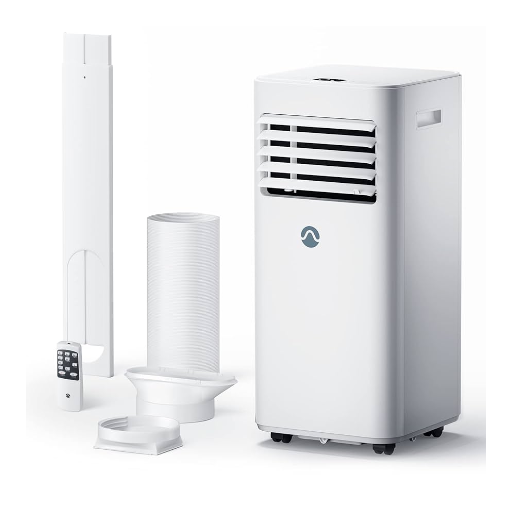
Upfront Costs of Air Conditioners and Dehumidifiers
The primary costs associated with air conditioners and dehumidifiers can greatly differ and truly depend on the type, size, and features selected for the system considered. Air conditioners, with a central system taking first prize, or rather the brunt of the cost, tend to have higher installation costs. The cost of installing an AC system for an average-sized house ranges from $3,000 to $7,000. A portable air conditioner or a window air conditioner is a cheaper entry point, with prices usually between $150 and $800, though they tend to be less efficient in larger spaces.
Dehumidifiers, in contrast, range on the less expensive front at anywhere from $50 to $500 for portable dehumidifiers, depending on capacity, whereas whole-house dehumidifier systems may run the gamut from $1,000 to $2,800, including installation. In most cases, a dehumidifier may cost less in the initial phases compared to an air conditioner, but the choice ultimately depends on specific needs pertaining to the environment, for example, keeping the humidity levels down to prevent mold growth or maintaining a comfortable temperature indoors.
Consider value for money when selecting these appliances. For instance, expensive energy-saving air conditioners that meet the requirements of a SEER (Seasonal Energy Efficiency Ratio) of more than 16, and energy-efficient, ENERGY STAR-labeled dehumidifiers will help save on future utility bills with their lower power consumption. After considering these factors, a wise trade-off can be made between the upfront cost and ongoing savings, especially for applications demanding climate control over long periods, residential or commercial.
Maintenance Costs and Considerations
Expenditure on HVAC system maintenance can be classified as either routine or unanticipated. The former may include operations such as filter replacement, the cleaning of coils, and inspections that ensure that the equipment is maintained in operational condition and has a longer period of operation. Usually, filters are replaced every 1 to 3 months, the expenses going from $20 to $50 yearly, depending on the type of filter and usage of the system. Professional HVAC servicing should be carried out twice yearly; chilling costs may set in anywhere between $150 and $500, depending on the service.
Regarding unexpected repairs, events such as refrigerant leak repairs or fan motor replacements could drastically affect maintenance costs. For example, repairs associated with refrigerants could be in the vicinity of $200–$1,500, depending upon labor and system details. Buying extended warranties or service contracts could provide a cost-effective way of avoiding unforeseen expenses by offering coverage over essential components.
Predictive maintenance thus can make an impact on cost reduction. Advanced monitoring sensors and Internet-based systems are able to detect anomalies, forecast failures, and even plan for maintenance well before serious consequences can occur. Although there is some upfront investment into these technologies, the savings on a long-term basis through avoided breakdowns and improved system efficiencies make them a worthwhile expenditure for both homeowners and commercial users.
References
-
University of Missouri Extension: Dehumidifiers – MU Extension
This source explains how central air conditioning reduces humidity and when a dehumidifier might be necessary. -
Cornell Cooperative Extension: Selecting a Dehumidifier
This resource highlights the primary function of dehumidifiers and contrasts it with air conditioners. -
Penn State Dutton Institute: Environmental Protection | EGEE 102
Discusses the interaction between dehumidifiers and air conditioners, including their impact on cooling loads. -
Florida Academy: The Effects of Humidity on an HVAC System
Explores how dehumidifiers can complement air conditioners to manage humidity and improve efficiency. -
U.S. Department of Energy: Central Air Conditioning
Provides insights into energy use and the combined operation of dehumidifiers and air conditioners.
Frequently Asked Questions (FAQ)
Q: What is the main difference between a dehumidifier and an air conditioner?
A: The main difference between a dehumidifier and an air conditioner is their primary function. A dehumidifier is designed to remove excess moisture from the air, reducing humidity levels, while an air conditioner cools the air to maintain a comfortable temperature in a room.
Q: Can a dehumidifier cool the air like an air conditioner?
A: No, a dehumidifier doesn’t cool the air. Its main function is to extract moisture from the air, which can make the room feel less humid but does not lower the temperature significantly like an air conditioner does.
Q: Which one consumes less electricity: a dehumidifier or an air conditioner?
A: Generally, a dehumidifier consumes less electricity than an air conditioner. This is because the dehumidifying function requires less energy compared to the cooling process of an air conditioner, especially when using portable units.
Q: Is it possible to use a dehumidifier and an air conditioner together?
A: Yes, using a dehumidifier and an air conditioner together can be beneficial. The air conditioner cools the room while the dehumidifier removes excess moisture from the air, leading to a more comfortable environment overall.
Q: How does a dehumidifier work compared to an air conditioner?
A: A dehumidifier works by drawing air into the unit, removing moisture, and then circulating drier air back into the room. In contrast, an air conditioner cools the air by passing it over cold coils, which also removes some moisture in the process but primarily focuses on lowering the temperature.
Q: What are the benefits of using a dehumidifier?
A: The benefits of using a dehumidifier include reducing humidity levels, preventing mold growth, improving air quality, and making the environment feel cooler without actually lowering the temperature. This can be particularly useful in humid climates.
Q: Can a good quality dehumidifier improve air conditioning efficiency?
A: Yes, a good quality dehumidifier can improve air conditioning efficiency by reducing the humidity level in the room. This allows the air conditioner to cool the air more effectively, as it doesn’t have to work as hard to remove moisture.
Q: What should I consider when choosing between a dehumidifier and an air conditioner?
A: When choosing between a dehumidifier and an air conditioner, consider the climate of your area, the amount of humidity you need to manage, your cooling needs, and energy consumption. If you primarily need to reduce humidity, a dehumidifier is ideal, while an air conditioner is better for cooling the air.

